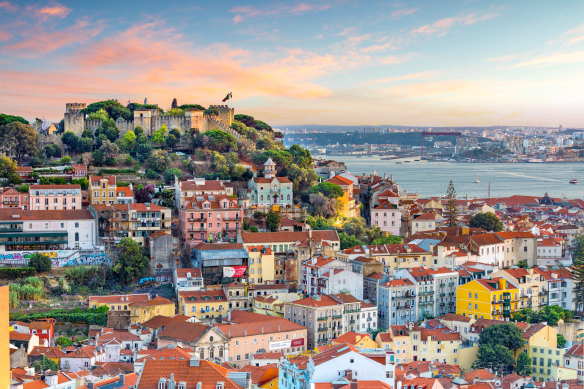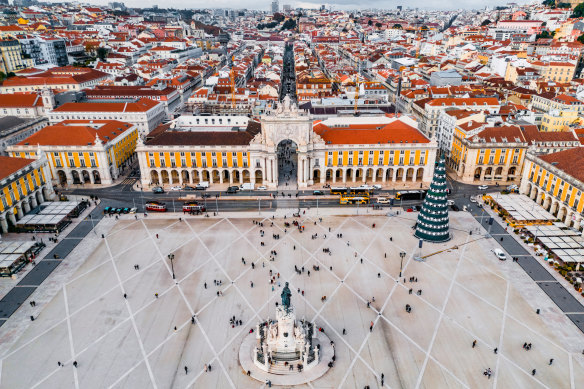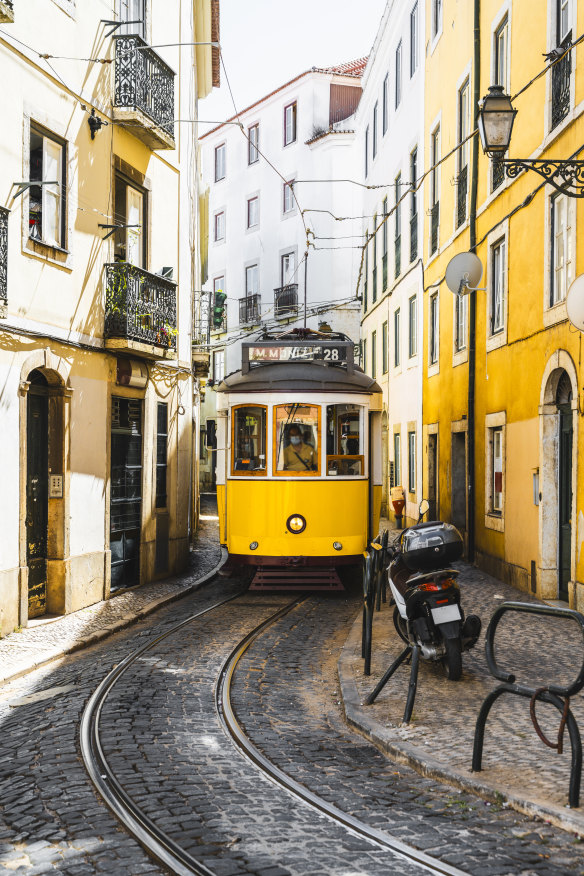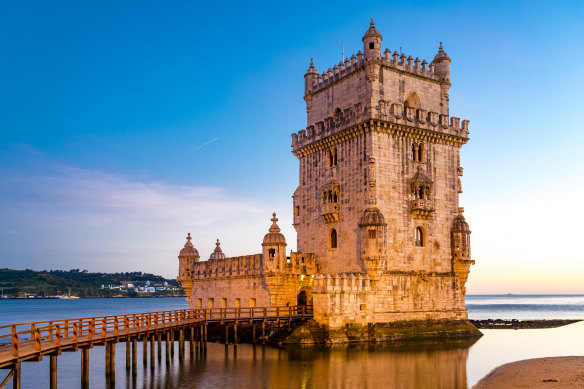This was published 5 months ago
Why tourists are converging on Europe’s second-oldest capital city
The past is never far away in Portugal’s resurgent capital, which embraced shabby chic long before it became fashionable.

The Castelo de São Jorge at sunset.Credit: Getty Images
This year is a significant anniversary in Portuguese history: it is 50 years since the Carnation Revolution ended a four-decade dictatorship established by António Salazar. With it, democracy came to Portugal, paving the way for the country’s 1986 entry into the European Economic Community.
In the years since, much has changed, and that’s especially true in the country’s capital, where the population and annual visitor numbers have since doubled. Lisbon has been discovered by tourists, investors and digital nomads alike; in 2022, under a controversial golden visa scheme introduced during the global financial crisis, an estimated 1300 millionaires moved in.
But climb to the hilltop viewpoint at the Miradouro da Senhora do Monte, and it’s like nothing has changed. Sprawling beyond is a fairytale landscape of terracotta-crowned roofs, centuries-old church towers and stony squares. In the distance are the medieval crenellated battlements of the Castelo de São Jorge. At that highest point of the city, on the widest stretch of the Tagus River at the westernmost edge of Europe, you grasp why the Carthaginians, Romans, Visigoths, Moors and some of today’s most successful capitalists have all been keen to call Lisbon home.
Thought to have been founded as a trading port city in 1200BC, Lisbon predates Rome. Like Paris, it is also described as the city of light. And it is soon set to tie with Córdoba, Spain, as the city with the most World Heritage Site listings. Its latest, flagged as “tentative”, is for the entire downtown and its “global legacy” – in particular, its medieval sections, 15th-century Age of Discovery ruins, and the extensive renovations that followed a 1755 earthquake.
That seismic event levelled much of old Lisbon, and so the Marquis de Pombal – who was also responsible for ramping up the production of port from the northern Portuguese city of Porto to the world – resolved to rebuild the city to be grander than before. The downtown quarter, the Marquis’ crowning achievement, is the only part of Lisbon which can be deemed organised. Its grid-like streets and neoclassical facades are well-preserved, and a massive riverside square features a triumphal arch, the Praça do Comércio, which serves as an entrée into the city’s dramatic history, the vastness of its sky and the hint of dust in its golden light.

Christmas decorations in the Praça de Comércio.Credit: Getty Images
It’s all uphill from there. Lisbon isn’t known as “the city of seven hills” for nothing. All roads lead to the Castelo de São Jorge and its 11th-century ramparts. On the way, there’s a labyrinth of basalt and limestone paving to explore. (The calçada portuguesa, or Portuguese pavement, is a source of national pride.) Whenever you get tired, there’s a square to stop in. The first quiosque in a square opened in 1869, and it and the dozens that followed are glorious art nouveau time machines. They sell wine and beer by the glass, traditional refreshments such as fried fish and ham sandwiches, and sorbet.
The quiosques, and how functional they remain today, are an example of how Lisbon has layered era upon era in its streetscapes. If at times it seems chaotic, that’s probably a reflection of centuries of exploration, trade, colonialism, slavery, revolt and war. One neighbourhood worth searching out that was saved from the earthquake is Alfama. Once the Moorish quarter, its name is from the Arabic Al-hamma, meaning “hot fountains or baths”. The streets in the second-oldest neighbourhood in Europe are confounding, though the well-travelled 28E line on one of Lisbon’s yellow trams takes you through it. In the evening, as the tram climbs towards the castle, riders may even hear fado music on the breeze.

One of Lisbon’s yellow trams passes through a narrow street in the Alfama district.Credit: Getty Images
Fado is on another UNESCO list, one detailing intangible cultural heritage elements, and can be traced to the 1820s in Lisbon. The Casa-Museu Amália Rodrigues is a museum devoted to the late Portuguese fado diva, but the music she sang remains alive and well in Alfama’s many cafes. Mesa da Frades, built in a former chapel with its original tiles and murals, is a fittingly intimate venue for fado’s aching romance and melancholy. As Rodrigues herself explained it, “The fado is not meant to be sung; it simply happens. You feel it.”
That spirit of fado is everywhere in Lisbon, its pretty peeling paint and artfully deteriorating facades. The city was shabby chic before it was trendy and will be long after. Perhaps for tourists, as with fado, the city is not meant to be seen so much as felt. That might be why after multiple trips to Lisbon, I still don’t have a list of its essential sights.
Instead, what stands out are moments of beauty and strangeness. There was the afternoon at the Botanical Garden, established in the 19th century to showcase the treasures of Portugal’s colonies, where I followed a black cat through coral trees and ferns plucked from Mozambique and Brazil. Or the spring day I roamed around the ruins of Castelo de São Jorge imagining past kings and queens in ermine-lined gowns by its grass moat and crumbling turrets. Every photo of that visit – you cannot take a bad picture here – is bathed in what looks to be a golden filter. It’s that famous Lisbon light. As the author Fernando Pessoa once wrote, it “falls so serenely and perfectly on things, gilds them with such sad, smiling reality”.
Pessoa, a literary giant of Portugal, is buried in the Belém district’s Jerónimos Monastery. His modernist masterpiece, The Book of Disquiet, which was drawn from fragments found in a suitcase after he died in 1935, is partly a meditation on loss. It also suggests something profound about the Portuguese mindset and its combination of fatalism and expansiveness. In a poem from that collection, Tabacaria (The Tobacco Shop), he writes: “I’m nothing / I’ll never be anything / Apart from that, I have within me all the dreams of the world.”

The World Heritage-listed Tower of Belém at sunset.Credit: Getty Images
At the World Heritage-listed Tower of Belém, built in the 1500s, that awareness of what lies beyond Portugal is on full display. A rhinoceros carved among the tower’s decoration is said to be Europe’s first representation of the animal in art. Because the Portuguese began sailing to Africa and then to much of the rest of the world so early, they were seeing and reporting back on parts of the world Europeans had yet to visit.
While the excesses of colonialism are now better understood, the Age of Discovery and the empire that ensued nonetheless represent a high point for Portugal and its culture. The Portuguese word saudade, which describes a feeling of longing or nostalgia that is not entirely painful, speaks to this. The past is never far away in Lisbon, as at the Convento do Carmo in the centre of town. Packed with parishioners on the Sunday morning of the great earthquake, the church was mostly destroyed. The caved-in roof was not replaced out of respect for the dead and an open-air space and lawn remains beneath a few soaring arches.
Featured on plaques throughout the city, and as formative to Portugal’s sense of self as Dorothea Mackellar’s My Country is to Australians, is Sophia de Mello Breyner Andresen’s poem Lisboa, after the capital’s Portuguese name. “Lisbon cruelly built next to its own absence,” it goes, and try not to think of these words when you see Sé, the city cathedral – and then learn it was built in the 12th century on the site of what was a grand mosque, itself constructed over Roman ruins.
Such deep thoughts require sustenance. Fernando Pessoa’s favourite cafe happened to be what is now Lisbon’s oldest: the Martinho da Arcada, across from the arch. Even the city’s buzziest restaurant, Pica-Pau, is haunted by ghosts as it pays homage to traditional Portuguese cooking. (The name is a working-class bar snack of meat cubes in beer sauce.) On a lovely patio you can opt for gizzard stew, or the restaurant’s spin on Portugal’s national dish, salt cod, this time fried into crispy cakes. Naturally, the city boasts 17 Michelin-starred restaurants. Still, the only food you simply must eat is the ubiquitous pastel de nata, or custard tart.
Swiss by birth, Pascal Mercier nonetheless wrote perhaps the most celebrated novel about the Portuguese capital, Night Train to Lisbon. In that book, Mercier wrote, “life is not what we live; it is what we imagine we are living”. Those lines are never more blurred than in Lisbon, a city devoted to imagining.
To read more from Good Weekend magazine, visit our page at The Sydney Morning Herald, The Age and Brisbane Times.